| [Thanks to Tree‘s urging me to take one of Joanna Macy’s Work That Reconnects workshops, I’ve been working through the online videos of her workshop for facilitators, and found it inspiring. Here are my notes and sketches from the videos.]
This diagram illustrates Joanna’s five-step personal ‘Work That Reconnects’ process, described in her book Coming Back to Life:
She argues that gratitude is a revolutionary act — that it contradicts the relentless message of the industrial growth society that we, and what we have, are never enough, so we are made to be perpetually dissatisfied. Gratitude breaks this hold on us, showing us that we are sufficient, and hence liberates us from industrial growth society’s propaganda, mindset and entrenched behaviours. Next, she introduces the three elements of the “great turning”, a concept that her colleague David Korten wrote a book about. The turning, she says, is from the industrial growth society to a life-sustaining society. It’s a three-stage shift:
The above chart really appeals to me for several reasons:
To get this all started, we need to talk. One-on-one, in small groups, in unofficial meetups and conferences. We will need a name that says what we’re for, not what we’re against. Our product will be practical ideas and actions on how to stop the worst aspects and abuses of the industrial growth economy, relentlessly. We must put the corporatist criminals out of business. Just as the people of some neighbourhoods have taken their neighbourhoods back from street gangs by collective action, by standing up to them, it is time for us to develop collective strategies that will take our beleaguered planet back from the corporatist criminals who are brutalizing and terrorizing us and our world.
For those following Joanna’s videos, this takes us to the end of the sixth video. The seventh video describes an exercise that Joanna uses to advance the Being Present stage of the work that reconnects, called “the Milling”, that entails random walks of the group around the room and then five ‘stops’, each with a different set of instructions for non-verbal communication one-on-one with a different partner, whose objective is to increase the participant’s sense of presence and awareness, and capacity for attention and appreciation for others doing the work that reconnects. This is going to be a difficult journey, one requiring great commitment and collaboration, and we need, Joanna says, to develop in ourselves a reciprocal love, kindness, compassion, respect, joy and peacefulness for others sharing that journey, to sustain ourselves through it. What Joanna calls “despair work”, honouring our pain for the world (or what I’ve called our unbearable grief for Gaia), she addresses in several ways (again, e.g. through Open Sentence or Milling exercises, or small-group exercises) including an intriguing whole-group exercise called The Truth Mandala. She lays out a large circle in the room with four quadrants, into which she places a bunch of dead leaves, a stick, a stone, and an empty bowl respectively. In the centre she places a napkin: She explains that each quadrant represents a set of emotions that stem from our pain for the world, as noted above. She goes on to describe how this exercise should be carried out:
Joanna also uses a breathing meditation practice she calls “breathing through”, for coping, honouring our pain and staying aware. It entails picturing us being “breathed by life”, and by letting life’s images of pain, suffering, violence or even numbness “breathe through us”, through our hearts (letting our hearts be broken) and then released to the vast healing power of Gaia and the world. This is not meant as a means of coping with the pain and grief, but instead as an awareness practice, preparatory to action. The next step is the process of creating the courage to act, what Joanna (referring to the work of Joseph Campbell and Jung and Bateson) calls the realization of The Ecological Self, through a journey not to hyper-individualistic perfection but to self-knowledge and discovery and connection, by moving towards what we fear. She refers to the deep ecology movement, and describes a process by which we actually shift identity from the separate one which the industrial growth society ascribes to us to one which is a part of and connected with all life on Earth, in permanent flux, imperfect, amoral, unbounded, ego-less. We are not doing this work because it is ethical, responsible, the right thing for us to do for some “other”. We are doing it because it is in the collective “self”-interest of all-life-on-Earth, which is our self-interest. Joanna is a big fan of systems theory and systems thinking, as a means of achieving the Seeing With New Eyes step of the Work That Reconnects. Readers will be familiar with Dana Meadows’ points to intervene in a system, and the flow view of reality rather than the traditional (since the Renaissance, anyway) element, building-block, “stuff-based” view. Under the “stuff-based” view, power is a property, and is about how one object can dominate or have command over another; it’s about competition and scarcity and defense. The ecological systems or “relationship/pattern-based” view, by contrast, is one of continuous flows, one of how instead of what. Under this worldview, power is power with, not over, it’s about cooperation and abundance and generosity. The self is then reconceived as not a separate, defined set of stuff, as we’ve been conditioned to think, but as an integral relationship. The four useful properties of systems for “New Eyes” ecological thinking are: (1) every system is an indivisible, unanalyzable whole with synergies and emergent properties, (2) systems self-regulate in their collective interest through feedback (the basis of Gaia theory), (3) systems evolve and adapt when stressed, and (4) all systems are holons (i.e. have subsystems with the same properties). Joanna offers a game called “The Systems Game”, described in her book, to practice this thinking. She also talks about other wisdom traditions (Eastern religions, paganism, indigenous spirituality, eco-feminism, some martial arts, as well as the deep ecology movement) that can help with this thinking as well. Another exercise Joanna uses to enable “New Eyes” thinking is called Widening Circles or the Four Voices Exercise. Participants gather in threes and each takes 15 minutes to move an argument of their choosing through four perspectives:
One way of moving beyond this short-term thinking is a “deep time” ritual exercise called Harvesting the Gifts of our Ancestors. It involves the group physically moving backwards in widening circles, as if through time, to the dawn of humanity, and then forward again, with a musical and narrative accompaniment. This is a fascinating imaginative exercise that I’d enjoy experiencing. Another technique is the Seventh Generation exercise, where participants arranged in a double circle imagine and re-enact a conversation between today’s citizens (outside circle moving in one direction) and those 7 generations hence (inside circle moving in the opposite direction). The topics are selected questions that the facilitator asks that are answered alternatively by the inner and outer circles (e.g. “Ancestor, what is it like to live in a world of such violence, species extinction and inequality?”). The assumption is that human exist and live sustainably 7 generations hence in 2200, with some knowledge of history in 2010. For the final step in the Work That Reconnects, Acting on what we know (Joanna calls this “going forth”), an exercise that is used called Goals & Resources entails partnering and taking turns asking and answering six collaborative questions:
The group also contributes resources that they can offer each other, and each person concludes by reading back what their partner undertook to do, to them as their “marching orders from the universe”. Joanna suggests that people interested in this work, attend a workshop to learn to facilitate, and then pull together a study group that goes through the process above and some of the exercises to help them move forward. I’m looking forward to getting a copy of the book, and hope to attend one of her facilitation workshops in the next year. It’s a great framework. I think Keith Farnish’s book Time’s Up provides some further guidance on the Taking Back the Earth dimension of this framework, which I’ll write more about soon. I also think it’s essential that we work together to refine and align our answers to the 6 questions above. We have to start looking at The Work That Reconnects as a kind of “Natural Enterprise”, one where we need to work collaboratively to identify what we’re uniquely equipped to do, and want to do, to bring about this great turning, and then apply those gifts and passions in “enterprises” with those whose gifts complement our own. More about that soon too. Category: Activism: What You Can Do
|








Very interesting. I like the “take back the Earth” slogan. I like “anti-civ” too. Much of this work Joanna is doing seems like it could be a good step for the newly clued. On the other hand, those of us who KNOW, who have grieved and milled about and talked endlessly… well, do we really need more contrived exercises in safe rooms? For us, it seems just more of the same, BAU.When a person wants to be fit, and has spent time in gyms, there comes the day when they have to decide if they want to live their life in an active mode, so the artificial environment of the gym is no longer needed. So for us too… Sometimes I wonder if we are all crippled, and no more able to jump than that proverbial about-to-boil frog…
Dave, my impression from your description of the ‘Work That Reconnects’ process is that the main potential value is how it provides a conceptual structure for personal action. It doesn’t seem to delve so much into how things work–ecology, economics, history, politics, psychology, and so on–so you have to come to it knowing that things are terribly wrong. Some will already blame “civilization”, or “industrialism”, or whatever, but I think participants will arrive knowing in their guts that big pain is felt and big changes are needed. Or maybe you didn’t emphasize her explanations of the world’s workings because you deal with them so much in your own writings already.Joanna seems to focus on offering people a way to understand their personal feelings and potential actions within a connected whole, the “great turning”. She is first offering a chance to be with others, not alone, when choosing how to act. Maybe that will allow some sort of collective intelligence to bear on the personal decisions. Second she is insisting that what we think of as personal–my pain, my action or lack of action–can be transformed into a collectively felt need. Perhaps the exercises lead to a sense of the world acting through us, rather than us being a bunch of individuals joining a movement.If that’s so (if I’m not misinterpreting), then Joanna is offering a change in consciousness. And it sounds like a change that won’t even allow us the possibility of inaction. It will just become too obvious what the need is, and that we must help.From this side of the looking-glass I can intellectually comprehend how things work and don’t work, I feel compassion for the world, I wish things were different, and I see limitations in every plan of action. I am stuck. Is Joanna’s workshop a path out of my morass, or will my ability to distance myself (to separate) prevent a useful change of consciousness?